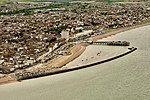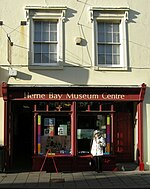Herne Windmill
1789 establishments in EnglandGrade I listed buildings in KentGrinding mills in the United KingdomMill museums in EnglandMuseums in the City of Canterbury ... and 6 more
Octagonal buildings in the United KingdomSmock mills in EnglandTourist attractions in KentUse British English from February 2023Windmills completed in 1789Windmills in Kent

Herne Windmill is a Grade I listed smock mill in Herne, Kent, England, that was built in 1789.
Excerpt from the Wikipedia article Herne Windmill (License: CC BY-SA 3.0, Authors, Images).Herne Windmill
Windmill Road, Canterbury Hunter's Forstal
Geographical coordinates (GPS) Address Nearby Places Show on map
Geographical coordinates (GPS)
| Latitude | Longitude |
|---|---|
| N 51.355277777778 ° | E 1.1369444444444 ° |
Address
Windmill Road
Windmill Road
CT6 7DL Canterbury, Hunter's Forstal
England, United Kingdom
Open on Google Maps









